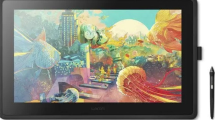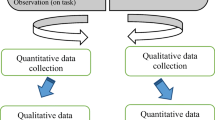Abstract
For this research, the authors identified writing-learning system requirements for words and sentences written by learners with intellectual disabilities. The requirements can be involved in their daily work composing letters and papers, and can be used to develop a system prototype. The implemented prototype was evaluated by expert-review examinations in this study, in which four expert teachers at a school for students with intellectual disabilities participated. Furthermore, the prototype was used at the school for system evaluation. This paper presents results and describes the system’s educational effects and expected difficulties related to future use.
You have full access to this open access chapter, Download conference paper PDF
Similar content being viewed by others
Keywords
1 Introduction
Handwriting tends to pose a daunting challenge to students who receive special needs education (SNE). The authors have investigated the use of tablet computers with a handwriting-learning system for special needs education [1, 2]. Especially for education for students with intellectual disabilities, the outcomes of learning with such systems are expected to be related directly with their actual daily life. Therefore, the authors’ earlier research has been augmented to identify writing-learning system requirements for words or sentences written by learners with intellectual disabilities that can be involved in their daily work such as in letters and papers, and to develop a system prototype [3]. However, the prototype has not been evaluated in any educational scene. In this research, the implemented prototype was evaluated based on expert-review examinations. It was used at the school for system evaluation.
2 System Development
The prototype system was developed by expanding our previous handwriting-learning systems, which were intended for handwriting-learning of words and sentences [1, 2]. System development was based on an Android tablet PC (Excite Write; Toshiba Corp.) including an electromagnetic-guidance digitizer.
When conducting this research, we devoted attention to the reuse of learning outcomes for producing new documents or works in real life. In SNE schools for students with intellectual disabilities in Japan, sometimes handwriting-learning outcomes were reused to produce documents or works. For example, SNE teachers prepare writing-sheets including some support-lines of character boxes or traced characters. Then they instruct their students to write words and sentences on the sheets. Subsequently, teachers erase the support-lines, cut out the written words and sentences, and put them on a template of letters or papers. However, much time and effort of teachers are required for such procedures [3]. Therefore, we tried to develop a prototype system by which all of the above procedures can be done. In other words, the prototype system in this study is intended for the following.
-
It is useful for including letters or papers of the ultimate objective.
-
It is useful for educating people to understand sentences and words.
-
It is useful for learning handwriting.
-
It is useful for the saving and reuse of produced texts.
In addition, the required system function has the following five points.
-
User Interface: setting of the user interface (e.g. hand dominance, contrast of display, and line width)
-
Template creation: image of the end objective is included in the system. It is used as a template.
-
Word/Sentence input: setting the location of words or sentences on the letters or papers of the end objective
-
Input supporting: setting of the support line, e.g., character box or traced characters
-
Saving outcome: saving of the written outcome with erased support lines; saving the file as printable.
3 System Evaluation
3.1 Expert Review
Expert reviewers were four SNE teachers (one was female, three were male) in a SNE school in Japan. They were 20–49 years old. All had sufficient experience of at least five years using ICTs for SNE.
Four questions were used to assess 10 items. Question 1 included five items related to the participant himself. All items were closed-ended questions. Question 2 included two items (one was a closed-ended question of five-grade evaluation; the other was an open-ended question) related to system purposes from learner and educator perspectives. Question 3 involved two items for system functions (one was a closed-ended question of five-grade evaluation; the other was an open-ended question). Question 4 was designed to elicit other opinions along with a written response.
The interviewer explained the purpose of the expert review to teachers. Then the interviewer demonstrated the system prototype and explained it. Subsequently, teachers were able to use the system freely. The interviewer received questions on the system. In the end, the interviewer gave teachers a questionnaire sheet and asked them to fill it out.
For data analysis of items with five-grade evaluations, we scored answers of “insufficient” as one point, “somewhat insufficient” as two points, “neutral” as three points “somewhat sufficient” as four points, and “sufficient” as five points. Mean scores of four teachers were required for each item. Table 1 presents mean scores assigned by the four teachers to system purposes (Qu. 2). Table 2 shows those assigned to system functions (Qu. 3).
In addition, from data analysis of the description items (Qu. 2 and 3), many positive opinions related to the prototype system were pointed out. Some needs of system improvements were confirmed, such as the user interface and support of learning.
3.2 System Usage
Among the expert reviewers above, one teacher cooperated with the system use for education of his student in the SNE school. The student was an eleventh-grade boy who was diagnosed as having autism and intellectual disability. Regarding handwriting, he was able to write his own name perfectly. He was also able to write other characters, but not perfectly, as long as he had a sample text. Moreover, he was unable to understand the meanings of the words and sentences the he had read.
The teacher used the system for the student’s learning for a month to make two end objectives. One was a presentation draft. The other was group efforts for graduates. After the usage, the teacher reported that the student was able to write more beautiful characters using the system than when using a previous method (paper with pen). Moreover, although the workload for preparation was increased slightly, that for the students’ support to achieve the ultimate objectives was reduced considerably.
4 Discussion
Regarding expert reviews, mean scores assigned by the four reviewers were over 4.0 for 4 items among 5 items of system purposes as well as 4 items among 5 items of system functions. Results showing a high score of more than 4.0 were shown for many items, implying high educational effects of the prototype system. Especially, for the item of “for saving and reusing of outcome” in the evaluation of system purposes and that of “saving outcome” in the evaluation of system function, all reviewers assigned the highest score. Such usable aspects of the items can be regarded as a good point of the prototype system. However, lower mean scores of less than 4.0 were found in the item of “for handwriting learning” on system purposes and that of “user interfaces” on the system function. In relation with the former, the needs of real-time feedback were pointed out. With the latter, needs of much easier operation to realize users’ required works were shown as the opinions of reviewers. It is expected to be necessary to improve the system from such points of view in the future.
Regarding educational use in an SNE school, the teacher reported that the prototype system was useful for work not only of students but also of the teacher himself. Especially, from the teacher’s report, the workload for the students’ support to achieve the end objective was greatly reduced compared to the previous method of paper with pen. These results imply the educational effects of the prototype system. However, further system improvements are necessary on some points such as the user interface for words/sentence input. Therefore, we would like to try to improve the system, considering such opinions.
5 Conclusion
This research examined development of a prototype system for writing-learning of words or sentences for learners with intellectual disabilities. Such words and sentences can be involved in their daily work, perhaps as letters or papers of the end objective. The prototype was developed based on an android tablet PC. Then it was evaluated by expert-review examinations in which four expert teachers at an SNE school for students with intellectual disabilities participated. Moreover, the prototype was used in a class of an expert teacher of the above for additional system evaluation. Results demonstrated the educational effects of the prototype system overall. However, requests for improvements were pointed out considering the user interface and support of learning. In future studies, we would like to undertake improvements and further examination of educational uses for many students and teachers.
References
Watanabe, K., Sato, K., Nemoto, N., Kobayashi, I., Nunokawa, H., Ogasawara, N.: The handwriting learning support application for special needs education. In: Proceedings of 77th National Convention of IPSJ, vol. 4, pp. 829–830. Information Processing Society of Japan, Tokyo (2015) (in Japanese)
Kobayashi, I., Nemoto, N., Sato, K., Watanabe, K., Nunokawa, H., Ogasawara, N.: Japanese sentence handwriting learning system for special needs education. In: Proceedings of ASSETS 2015, pp. 325–326. ACM, Portugal (2015)
Sato, K., Sugisawa, A., Kobayashi, I., Ogasawara, N., Nunokawa, H.: Development of teaching material application for applying learning outcomes to the real life for students with intellectual disabilities. JSiSE Research Report, vol. 30, no. 4, pp. 39–42. Japanese Society for Information and Systems in Education, Tokyo (2015) (in Japanese)
Author information
Authors and Affiliations
Corresponding author
Editor information
Editors and Affiliations
Rights and permissions
Copyright information
© 2016 Springer International Publishing Switzerland
About this paper
Cite this paper
Kobayashi, I., Sato, K., Sugisawa, A., Inoue, G., Ogasawara, N., Nunokawa, H. (2016). Advancing Writing Work with Handwriting-Learning System for Students with Intellectual Disabilities. In: Stephanidis, C. (eds) HCI International 2016 – Posters' Extended Abstracts. HCI 2016. Communications in Computer and Information Science, vol 618. Springer, Cham. https://doi.org/10.1007/978-3-319-40542-1_38
Download citation
DOI: https://doi.org/10.1007/978-3-319-40542-1_38
Published:
Publisher Name: Springer, Cham
Print ISBN: 978-3-319-40541-4
Online ISBN: 978-3-319-40542-1
eBook Packages: Computer ScienceComputer Science (R0)




